Employee Training Methods and the Relevance of Kolb's Learning Theory
VerifiedAdded on 2023/06/18
|8
|2242
|175
Essay
AI Summary
This essay provides a detailed analysis of employee training and development methods within organizations, using Marks and Spencer as an example. It examines job responsibilities across different departments, identifies various training methods (on-the-job, off-the-job, and a combination), and discusses their respective advantages and disadvantages. The essay also explores ways to improve training programs, linking recommendations to relevant theories. Furthermore, it delves into learning theories, particularly Kolb's experimental learning theory, and discusses the importance of understanding learning styles for employees, line managers, and learning and development specialists. The conclusion emphasizes the significance of employee and learning management, offering recommendations for organizations to optimize their training and development initiatives. Desklib provides access to this and other solved assignments for students.

Essay
Paraphrase This Document
Need a fresh take? Get an instant paraphrase of this document with our AI Paraphraser
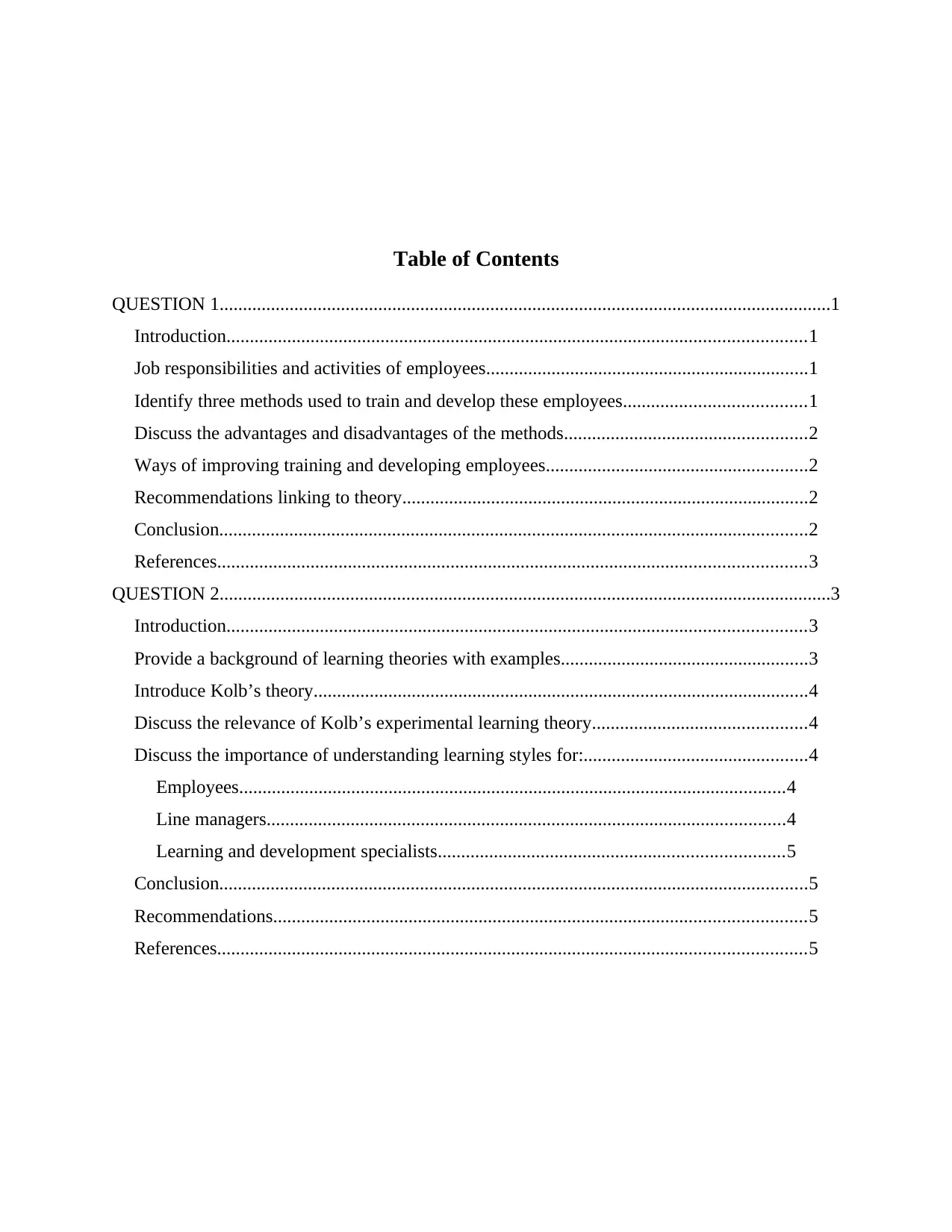
Table of Contents
QUESTION 1...................................................................................................................................1
Introduction............................................................................................................................1
Job responsibilities and activities of employees.....................................................................1
Identify three methods used to train and develop these employees.......................................1
Discuss the advantages and disadvantages of the methods....................................................2
Ways of improving training and developing employees........................................................2
Recommendations linking to theory.......................................................................................2
Conclusion..............................................................................................................................2
References..............................................................................................................................3
QUESTION 2...................................................................................................................................3
Introduction............................................................................................................................3
Provide a background of learning theories with examples.....................................................3
Introduce Kolb’s theory..........................................................................................................4
Discuss the relevance of Kolb’s experimental learning theory..............................................4
Discuss the importance of understanding learning styles for:................................................4
Employees.....................................................................................................................4
Line managers...............................................................................................................4
Learning and development specialists..........................................................................5
Conclusion..............................................................................................................................5
Recommendations..................................................................................................................5
References..............................................................................................................................5
QUESTION 1...................................................................................................................................1
Introduction............................................................................................................................1
Job responsibilities and activities of employees.....................................................................1
Identify three methods used to train and develop these employees.......................................1
Discuss the advantages and disadvantages of the methods....................................................2
Ways of improving training and developing employees........................................................2
Recommendations linking to theory.......................................................................................2
Conclusion..............................................................................................................................2
References..............................................................................................................................3
QUESTION 2...................................................................................................................................3
Introduction............................................................................................................................3
Provide a background of learning theories with examples.....................................................3
Introduce Kolb’s theory..........................................................................................................4
Discuss the relevance of Kolb’s experimental learning theory..............................................4
Discuss the importance of understanding learning styles for:................................................4
Employees.....................................................................................................................4
Line managers...............................................................................................................4
Learning and development specialists..........................................................................5
Conclusion..............................................................................................................................5
Recommendations..................................................................................................................5
References..............................................................................................................................5
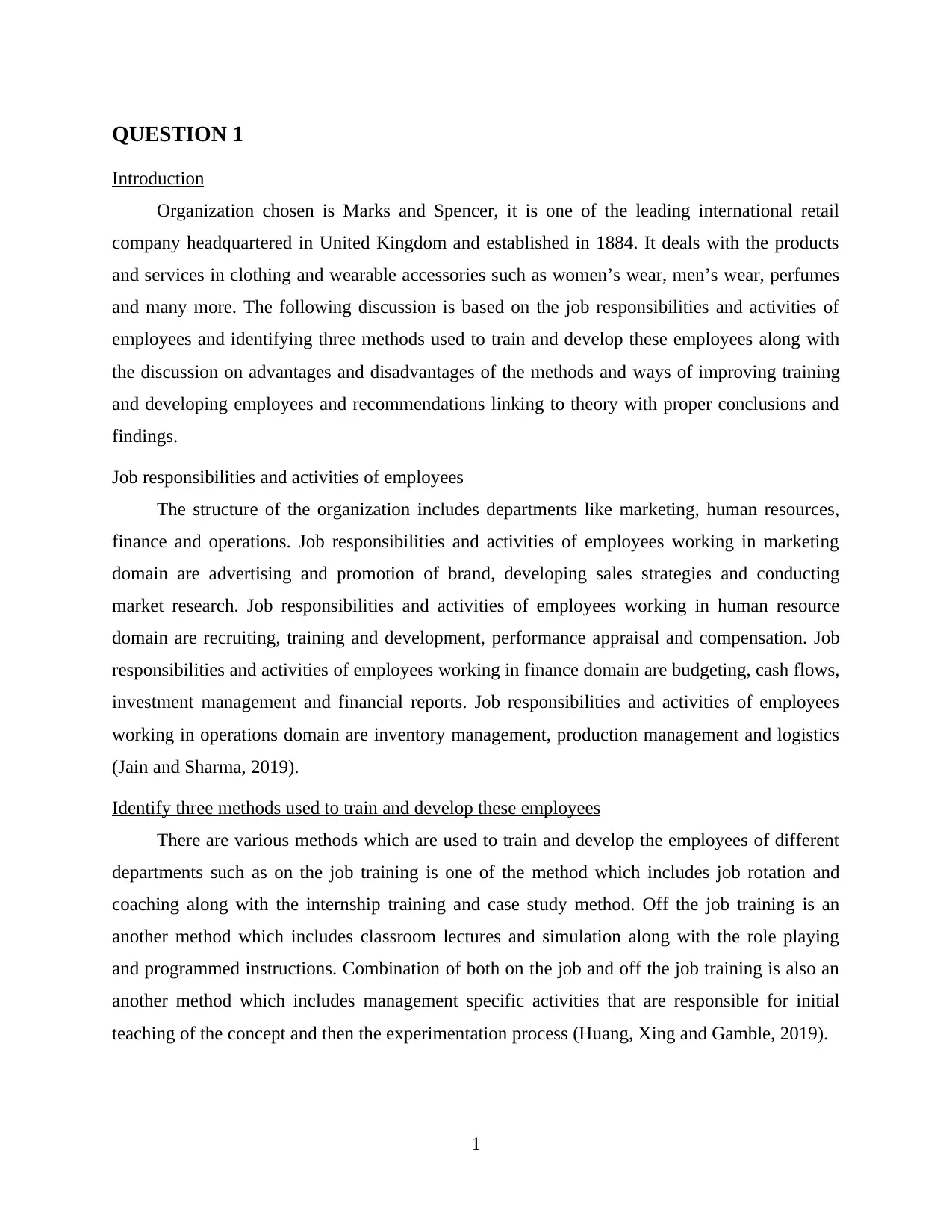
QUESTION 1
Introduction
Organization chosen is Marks and Spencer, it is one of the leading international retail
company headquartered in United Kingdom and established in 1884. It deals with the products
and services in clothing and wearable accessories such as women’s wear, men’s wear, perfumes
and many more. The following discussion is based on the job responsibilities and activities of
employees and identifying three methods used to train and develop these employees along with
the discussion on advantages and disadvantages of the methods and ways of improving training
and developing employees and recommendations linking to theory with proper conclusions and
findings.
Job responsibilities and activities of employees
The structure of the organization includes departments like marketing, human resources,
finance and operations. Job responsibilities and activities of employees working in marketing
domain are advertising and promotion of brand, developing sales strategies and conducting
market research. Job responsibilities and activities of employees working in human resource
domain are recruiting, training and development, performance appraisal and compensation. Job
responsibilities and activities of employees working in finance domain are budgeting, cash flows,
investment management and financial reports. Job responsibilities and activities of employees
working in operations domain are inventory management, production management and logistics
(Jain and Sharma, 2019).
Identify three methods used to train and develop these employees
There are various methods which are used to train and develop the employees of different
departments such as on the job training is one of the method which includes job rotation and
coaching along with the internship training and case study method. Off the job training is an
another method which includes classroom lectures and simulation along with the role playing
and programmed instructions. Combination of both on the job and off the job training is also an
another method which includes management specific activities that are responsible for initial
teaching of the concept and then the experimentation process (Huang, Xing and Gamble, 2019).
1
Introduction
Organization chosen is Marks and Spencer, it is one of the leading international retail
company headquartered in United Kingdom and established in 1884. It deals with the products
and services in clothing and wearable accessories such as women’s wear, men’s wear, perfumes
and many more. The following discussion is based on the job responsibilities and activities of
employees and identifying three methods used to train and develop these employees along with
the discussion on advantages and disadvantages of the methods and ways of improving training
and developing employees and recommendations linking to theory with proper conclusions and
findings.
Job responsibilities and activities of employees
The structure of the organization includes departments like marketing, human resources,
finance and operations. Job responsibilities and activities of employees working in marketing
domain are advertising and promotion of brand, developing sales strategies and conducting
market research. Job responsibilities and activities of employees working in human resource
domain are recruiting, training and development, performance appraisal and compensation. Job
responsibilities and activities of employees working in finance domain are budgeting, cash flows,
investment management and financial reports. Job responsibilities and activities of employees
working in operations domain are inventory management, production management and logistics
(Jain and Sharma, 2019).
Identify three methods used to train and develop these employees
There are various methods which are used to train and develop the employees of different
departments such as on the job training is one of the method which includes job rotation and
coaching along with the internship training and case study method. Off the job training is an
another method which includes classroom lectures and simulation along with the role playing
and programmed instructions. Combination of both on the job and off the job training is also an
another method which includes management specific activities that are responsible for initial
teaching of the concept and then the experimentation process (Huang, Xing and Gamble, 2019).
1
⊘ This is a preview!⊘
Do you want full access?
Subscribe today to unlock all pages.

Trusted by 1+ million students worldwide
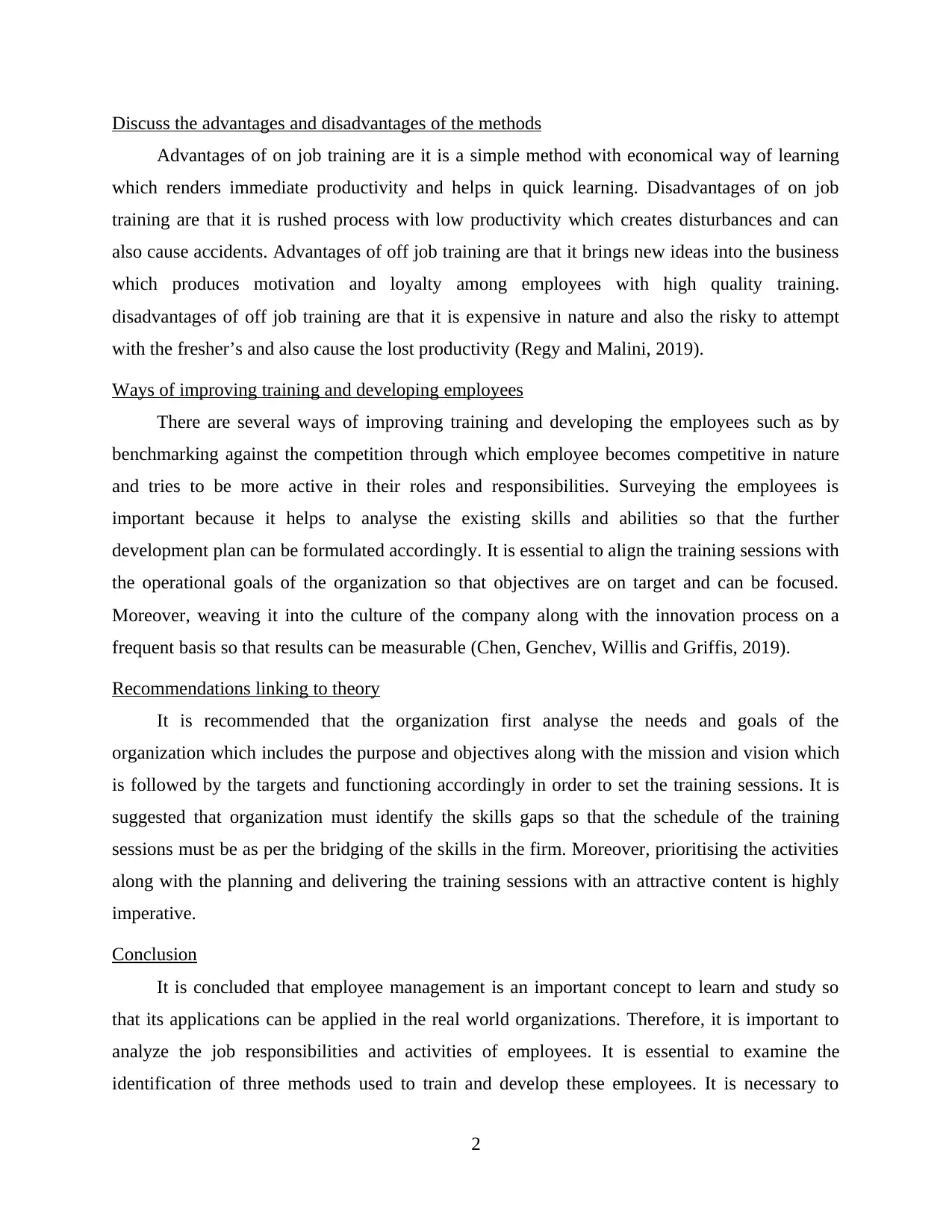
Discuss the advantages and disadvantages of the methods
Advantages of on job training are it is a simple method with economical way of learning
which renders immediate productivity and helps in quick learning. Disadvantages of on job
training are that it is rushed process with low productivity which creates disturbances and can
also cause accidents. Advantages of off job training are that it brings new ideas into the business
which produces motivation and loyalty among employees with high quality training.
disadvantages of off job training are that it is expensive in nature and also the risky to attempt
with the fresher’s and also cause the lost productivity (Regy and Malini, 2019).
Ways of improving training and developing employees
There are several ways of improving training and developing the employees such as by
benchmarking against the competition through which employee becomes competitive in nature
and tries to be more active in their roles and responsibilities. Surveying the employees is
important because it helps to analyse the existing skills and abilities so that the further
development plan can be formulated accordingly. It is essential to align the training sessions with
the operational goals of the organization so that objectives are on target and can be focused.
Moreover, weaving it into the culture of the company along with the innovation process on a
frequent basis so that results can be measurable (Chen, Genchev, Willis and Griffis, 2019).
Recommendations linking to theory
It is recommended that the organization first analyse the needs and goals of the
organization which includes the purpose and objectives along with the mission and vision which
is followed by the targets and functioning accordingly in order to set the training sessions. It is
suggested that organization must identify the skills gaps so that the schedule of the training
sessions must be as per the bridging of the skills in the firm. Moreover, prioritising the activities
along with the planning and delivering the training sessions with an attractive content is highly
imperative.
Conclusion
It is concluded that employee management is an important concept to learn and study so
that its applications can be applied in the real world organizations. Therefore, it is important to
analyze the job responsibilities and activities of employees. It is essential to examine the
identification of three methods used to train and develop these employees. It is necessary to
2
Advantages of on job training are it is a simple method with economical way of learning
which renders immediate productivity and helps in quick learning. Disadvantages of on job
training are that it is rushed process with low productivity which creates disturbances and can
also cause accidents. Advantages of off job training are that it brings new ideas into the business
which produces motivation and loyalty among employees with high quality training.
disadvantages of off job training are that it is expensive in nature and also the risky to attempt
with the fresher’s and also cause the lost productivity (Regy and Malini, 2019).
Ways of improving training and developing employees
There are several ways of improving training and developing the employees such as by
benchmarking against the competition through which employee becomes competitive in nature
and tries to be more active in their roles and responsibilities. Surveying the employees is
important because it helps to analyse the existing skills and abilities so that the further
development plan can be formulated accordingly. It is essential to align the training sessions with
the operational goals of the organization so that objectives are on target and can be focused.
Moreover, weaving it into the culture of the company along with the innovation process on a
frequent basis so that results can be measurable (Chen, Genchev, Willis and Griffis, 2019).
Recommendations linking to theory
It is recommended that the organization first analyse the needs and goals of the
organization which includes the purpose and objectives along with the mission and vision which
is followed by the targets and functioning accordingly in order to set the training sessions. It is
suggested that organization must identify the skills gaps so that the schedule of the training
sessions must be as per the bridging of the skills in the firm. Moreover, prioritising the activities
along with the planning and delivering the training sessions with an attractive content is highly
imperative.
Conclusion
It is concluded that employee management is an important concept to learn and study so
that its applications can be applied in the real world organizations. Therefore, it is important to
analyze the job responsibilities and activities of employees. It is essential to examine the
identification of three methods used to train and develop these employees. It is necessary to
2
Paraphrase This Document
Need a fresh take? Get an instant paraphrase of this document with our AI Paraphraser
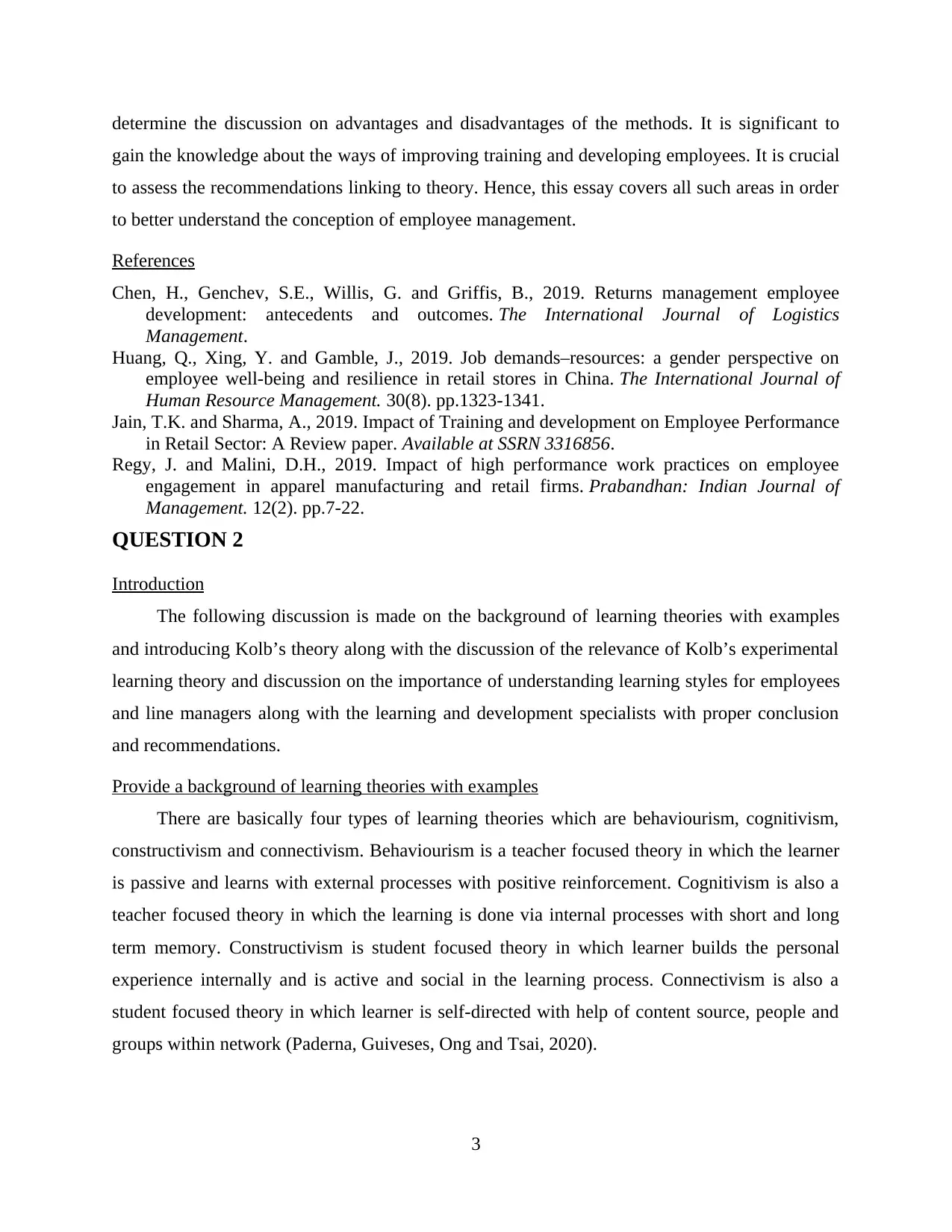
determine the discussion on advantages and disadvantages of the methods. It is significant to
gain the knowledge about the ways of improving training and developing employees. It is crucial
to assess the recommendations linking to theory. Hence, this essay covers all such areas in order
to better understand the conception of employee management.
References
Chen, H., Genchev, S.E., Willis, G. and Griffis, B., 2019. Returns management employee
development: antecedents and outcomes. The International Journal of Logistics
Management.
Huang, Q., Xing, Y. and Gamble, J., 2019. Job demands–resources: a gender perspective on
employee well-being and resilience in retail stores in China. The International Journal of
Human Resource Management. 30(8). pp.1323-1341.
Jain, T.K. and Sharma, A., 2019. Impact of Training and development on Employee Performance
in Retail Sector: A Review paper. Available at SSRN 3316856.
Regy, J. and Malini, D.H., 2019. Impact of high performance work practices on employee
engagement in apparel manufacturing and retail firms. Prabandhan: Indian Journal of
Management. 12(2). pp.7-22.
QUESTION 2
Introduction
The following discussion is made on the background of learning theories with examples
and introducing Kolb’s theory along with the discussion of the relevance of Kolb’s experimental
learning theory and discussion on the importance of understanding learning styles for employees
and line managers along with the learning and development specialists with proper conclusion
and recommendations.
Provide a background of learning theories with examples
There are basically four types of learning theories which are behaviourism, cognitivism,
constructivism and connectivism. Behaviourism is a teacher focused theory in which the learner
is passive and learns with external processes with positive reinforcement. Cognitivism is also a
teacher focused theory in which the learning is done via internal processes with short and long
term memory. Constructivism is student focused theory in which learner builds the personal
experience internally and is active and social in the learning process. Connectivism is also a
student focused theory in which learner is self-directed with help of content source, people and
groups within network (Paderna, Guiveses, Ong and Tsai, 2020).
3
gain the knowledge about the ways of improving training and developing employees. It is crucial
to assess the recommendations linking to theory. Hence, this essay covers all such areas in order
to better understand the conception of employee management.
References
Chen, H., Genchev, S.E., Willis, G. and Griffis, B., 2019. Returns management employee
development: antecedents and outcomes. The International Journal of Logistics
Management.
Huang, Q., Xing, Y. and Gamble, J., 2019. Job demands–resources: a gender perspective on
employee well-being and resilience in retail stores in China. The International Journal of
Human Resource Management. 30(8). pp.1323-1341.
Jain, T.K. and Sharma, A., 2019. Impact of Training and development on Employee Performance
in Retail Sector: A Review paper. Available at SSRN 3316856.
Regy, J. and Malini, D.H., 2019. Impact of high performance work practices on employee
engagement in apparel manufacturing and retail firms. Prabandhan: Indian Journal of
Management. 12(2). pp.7-22.
QUESTION 2
Introduction
The following discussion is made on the background of learning theories with examples
and introducing Kolb’s theory along with the discussion of the relevance of Kolb’s experimental
learning theory and discussion on the importance of understanding learning styles for employees
and line managers along with the learning and development specialists with proper conclusion
and recommendations.
Provide a background of learning theories with examples
There are basically four types of learning theories which are behaviourism, cognitivism,
constructivism and connectivism. Behaviourism is a teacher focused theory in which the learner
is passive and learns with external processes with positive reinforcement. Cognitivism is also a
teacher focused theory in which the learning is done via internal processes with short and long
term memory. Constructivism is student focused theory in which learner builds the personal
experience internally and is active and social in the learning process. Connectivism is also a
student focused theory in which learner is self-directed with help of content source, people and
groups within network (Paderna, Guiveses, Ong and Tsai, 2020).
3
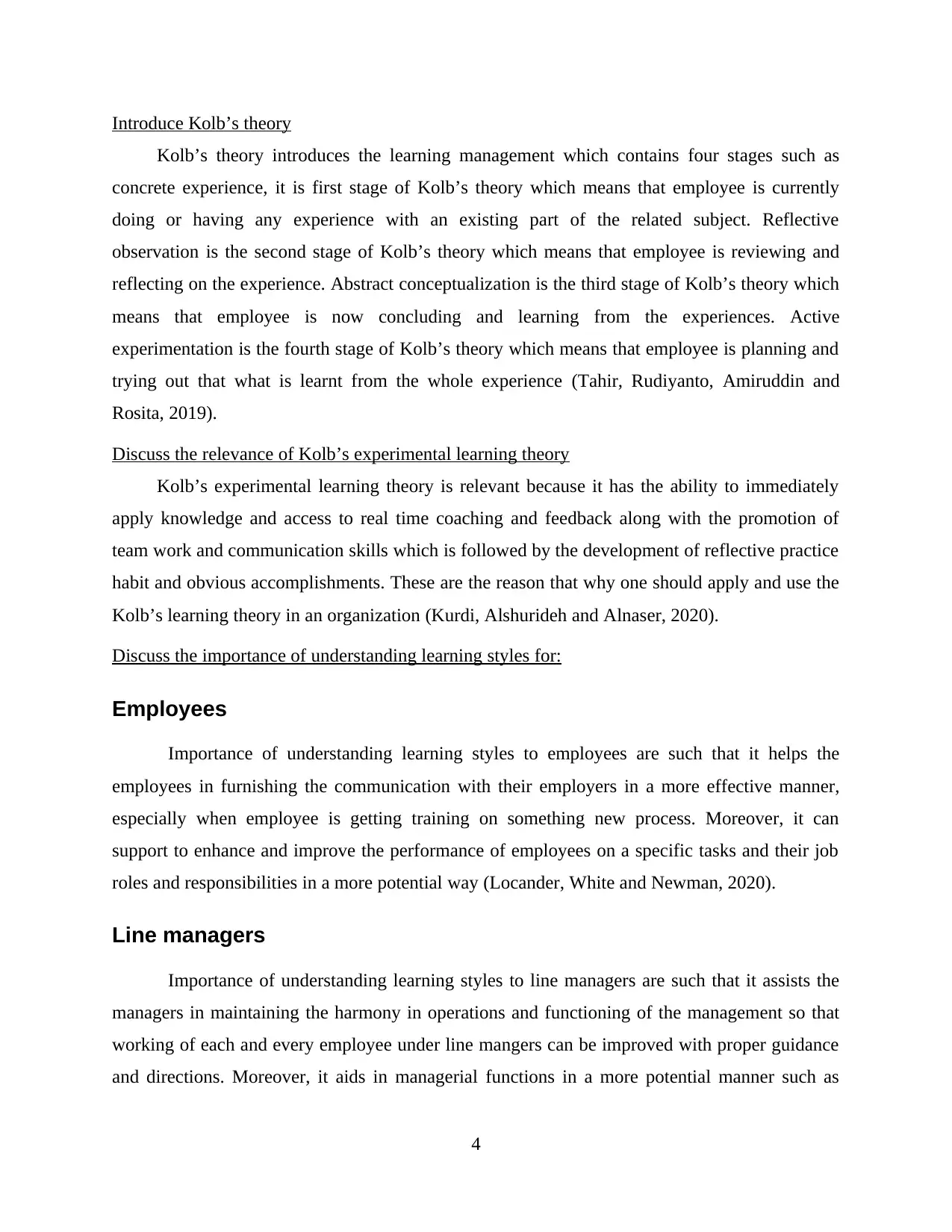
Introduce Kolb’s theory
Kolb’s theory introduces the learning management which contains four stages such as
concrete experience, it is first stage of Kolb’s theory which means that employee is currently
doing or having any experience with an existing part of the related subject. Reflective
observation is the second stage of Kolb’s theory which means that employee is reviewing and
reflecting on the experience. Abstract conceptualization is the third stage of Kolb’s theory which
means that employee is now concluding and learning from the experiences. Active
experimentation is the fourth stage of Kolb’s theory which means that employee is planning and
trying out that what is learnt from the whole experience (Tahir, Rudiyanto, Amiruddin and
Rosita, 2019).
Discuss the relevance of Kolb’s experimental learning theory
Kolb’s experimental learning theory is relevant because it has the ability to immediately
apply knowledge and access to real time coaching and feedback along with the promotion of
team work and communication skills which is followed by the development of reflective practice
habit and obvious accomplishments. These are the reason that why one should apply and use the
Kolb’s learning theory in an organization (Kurdi, Alshurideh and Alnaser, 2020).
Discuss the importance of understanding learning styles for:
Employees
Importance of understanding learning styles to employees are such that it helps the
employees in furnishing the communication with their employers in a more effective manner,
especially when employee is getting training on something new process. Moreover, it can
support to enhance and improve the performance of employees on a specific tasks and their job
roles and responsibilities in a more potential way (Locander, White and Newman, 2020).
Line managers
Importance of understanding learning styles to line managers are such that it assists the
managers in maintaining the harmony in operations and functioning of the management so that
working of each and every employee under line mangers can be improved with proper guidance
and directions. Moreover, it aids in managerial functions in a more potential manner such as
4
Kolb’s theory introduces the learning management which contains four stages such as
concrete experience, it is first stage of Kolb’s theory which means that employee is currently
doing or having any experience with an existing part of the related subject. Reflective
observation is the second stage of Kolb’s theory which means that employee is reviewing and
reflecting on the experience. Abstract conceptualization is the third stage of Kolb’s theory which
means that employee is now concluding and learning from the experiences. Active
experimentation is the fourth stage of Kolb’s theory which means that employee is planning and
trying out that what is learnt from the whole experience (Tahir, Rudiyanto, Amiruddin and
Rosita, 2019).
Discuss the relevance of Kolb’s experimental learning theory
Kolb’s experimental learning theory is relevant because it has the ability to immediately
apply knowledge and access to real time coaching and feedback along with the promotion of
team work and communication skills which is followed by the development of reflective practice
habit and obvious accomplishments. These are the reason that why one should apply and use the
Kolb’s learning theory in an organization (Kurdi, Alshurideh and Alnaser, 2020).
Discuss the importance of understanding learning styles for:
Employees
Importance of understanding learning styles to employees are such that it helps the
employees in furnishing the communication with their employers in a more effective manner,
especially when employee is getting training on something new process. Moreover, it can
support to enhance and improve the performance of employees on a specific tasks and their job
roles and responsibilities in a more potential way (Locander, White and Newman, 2020).
Line managers
Importance of understanding learning styles to line managers are such that it assists the
managers in maintaining the harmony in operations and functioning of the management so that
working of each and every employee under line mangers can be improved with proper guidance
and directions. Moreover, it aids in managerial functions in a more potential manner such as
4
⊘ This is a preview!⊘
Do you want full access?
Subscribe today to unlock all pages.

Trusted by 1+ million students worldwide
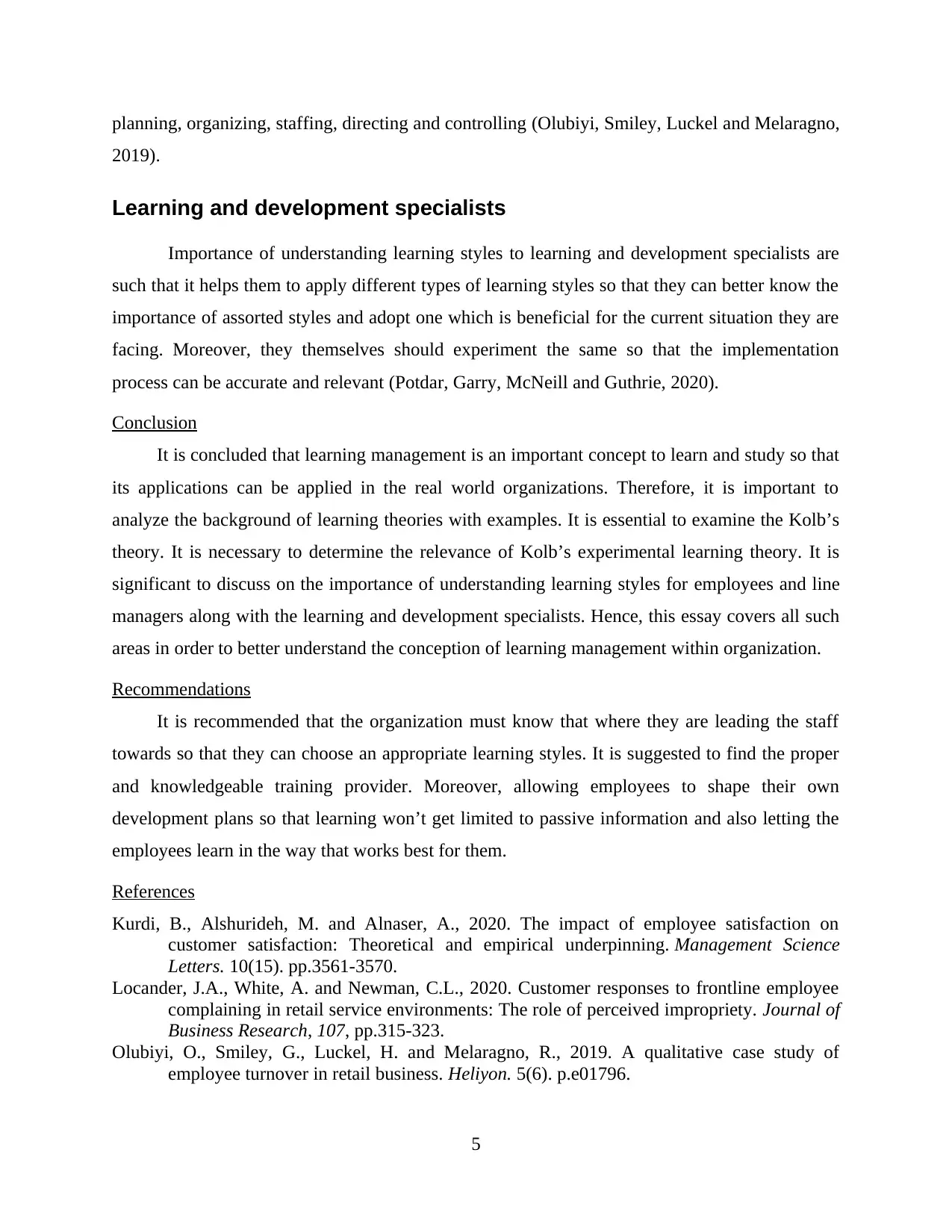
planning, organizing, staffing, directing and controlling (Olubiyi, Smiley, Luckel and Melaragno,
2019).
Learning and development specialists
Importance of understanding learning styles to learning and development specialists are
such that it helps them to apply different types of learning styles so that they can better know the
importance of assorted styles and adopt one which is beneficial for the current situation they are
facing. Moreover, they themselves should experiment the same so that the implementation
process can be accurate and relevant (Potdar, Garry, McNeill and Guthrie, 2020).
Conclusion
It is concluded that learning management is an important concept to learn and study so that
its applications can be applied in the real world organizations. Therefore, it is important to
analyze the background of learning theories with examples. It is essential to examine the Kolb’s
theory. It is necessary to determine the relevance of Kolb’s experimental learning theory. It is
significant to discuss on the importance of understanding learning styles for employees and line
managers along with the learning and development specialists. Hence, this essay covers all such
areas in order to better understand the conception of learning management within organization.
Recommendations
It is recommended that the organization must know that where they are leading the staff
towards so that they can choose an appropriate learning styles. It is suggested to find the proper
and knowledgeable training provider. Moreover, allowing employees to shape their own
development plans so that learning won’t get limited to passive information and also letting the
employees learn in the way that works best for them.
References
Kurdi, B., Alshurideh, M. and Alnaser, A., 2020. The impact of employee satisfaction on
customer satisfaction: Theoretical and empirical underpinning. Management Science
Letters. 10(15). pp.3561-3570.
Locander, J.A., White, A. and Newman, C.L., 2020. Customer responses to frontline employee
complaining in retail service environments: The role of perceived impropriety. Journal of
Business Research, 107, pp.315-323.
Olubiyi, O., Smiley, G., Luckel, H. and Melaragno, R., 2019. A qualitative case study of
employee turnover in retail business. Heliyon. 5(6). p.e01796.
5
2019).
Learning and development specialists
Importance of understanding learning styles to learning and development specialists are
such that it helps them to apply different types of learning styles so that they can better know the
importance of assorted styles and adopt one which is beneficial for the current situation they are
facing. Moreover, they themselves should experiment the same so that the implementation
process can be accurate and relevant (Potdar, Garry, McNeill and Guthrie, 2020).
Conclusion
It is concluded that learning management is an important concept to learn and study so that
its applications can be applied in the real world organizations. Therefore, it is important to
analyze the background of learning theories with examples. It is essential to examine the Kolb’s
theory. It is necessary to determine the relevance of Kolb’s experimental learning theory. It is
significant to discuss on the importance of understanding learning styles for employees and line
managers along with the learning and development specialists. Hence, this essay covers all such
areas in order to better understand the conception of learning management within organization.
Recommendations
It is recommended that the organization must know that where they are leading the staff
towards so that they can choose an appropriate learning styles. It is suggested to find the proper
and knowledgeable training provider. Moreover, allowing employees to shape their own
development plans so that learning won’t get limited to passive information and also letting the
employees learn in the way that works best for them.
References
Kurdi, B., Alshurideh, M. and Alnaser, A., 2020. The impact of employee satisfaction on
customer satisfaction: Theoretical and empirical underpinning. Management Science
Letters. 10(15). pp.3561-3570.
Locander, J.A., White, A. and Newman, C.L., 2020. Customer responses to frontline employee
complaining in retail service environments: The role of perceived impropriety. Journal of
Business Research, 107, pp.315-323.
Olubiyi, O., Smiley, G., Luckel, H. and Melaragno, R., 2019. A qualitative case study of
employee turnover in retail business. Heliyon. 5(6). p.e01796.
5
Paraphrase This Document
Need a fresh take? Get an instant paraphrase of this document with our AI Paraphraser
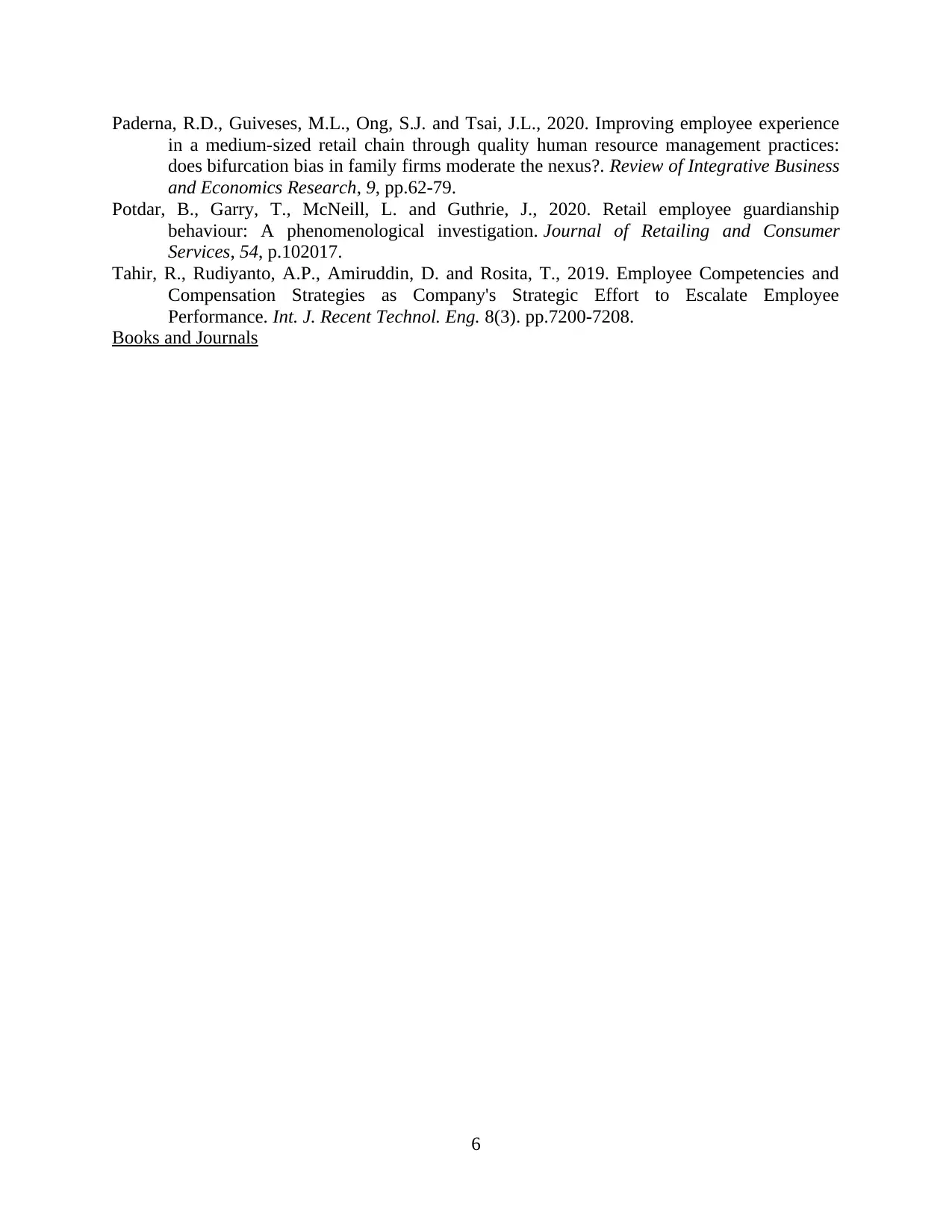
Paderna, R.D., Guiveses, M.L., Ong, S.J. and Tsai, J.L., 2020. Improving employee experience
in a medium-sized retail chain through quality human resource management practices:
does bifurcation bias in family firms moderate the nexus?. Review of Integrative Business
and Economics Research, 9, pp.62-79.
Potdar, B., Garry, T., McNeill, L. and Guthrie, J., 2020. Retail employee guardianship
behaviour: A phenomenological investigation. Journal of Retailing and Consumer
Services, 54, p.102017.
Tahir, R., Rudiyanto, A.P., Amiruddin, D. and Rosita, T., 2019. Employee Competencies and
Compensation Strategies as Company's Strategic Effort to Escalate Employee
Performance. Int. J. Recent Technol. Eng. 8(3). pp.7200-7208.
Books and Journals
6
in a medium-sized retail chain through quality human resource management practices:
does bifurcation bias in family firms moderate the nexus?. Review of Integrative Business
and Economics Research, 9, pp.62-79.
Potdar, B., Garry, T., McNeill, L. and Guthrie, J., 2020. Retail employee guardianship
behaviour: A phenomenological investigation. Journal of Retailing and Consumer
Services, 54, p.102017.
Tahir, R., Rudiyanto, A.P., Amiruddin, D. and Rosita, T., 2019. Employee Competencies and
Compensation Strategies as Company's Strategic Effort to Escalate Employee
Performance. Int. J. Recent Technol. Eng. 8(3). pp.7200-7208.
Books and Journals
6
1 out of 8
Related Documents
Your All-in-One AI-Powered Toolkit for Academic Success.
+13062052269
info@desklib.com
Available 24*7 on WhatsApp / Email
![[object Object]](/_next/static/media/star-bottom.7253800d.svg)
Unlock your academic potential
Copyright © 2020–2025 A2Z Services. All Rights Reserved. Developed and managed by ZUCOL.





